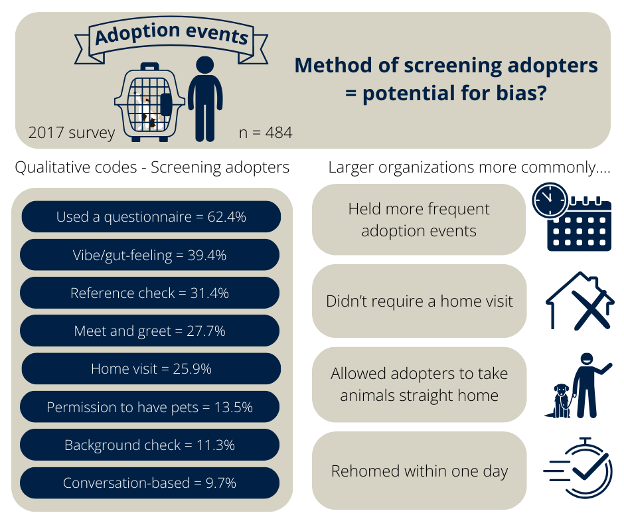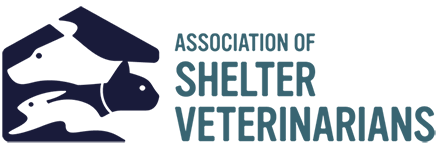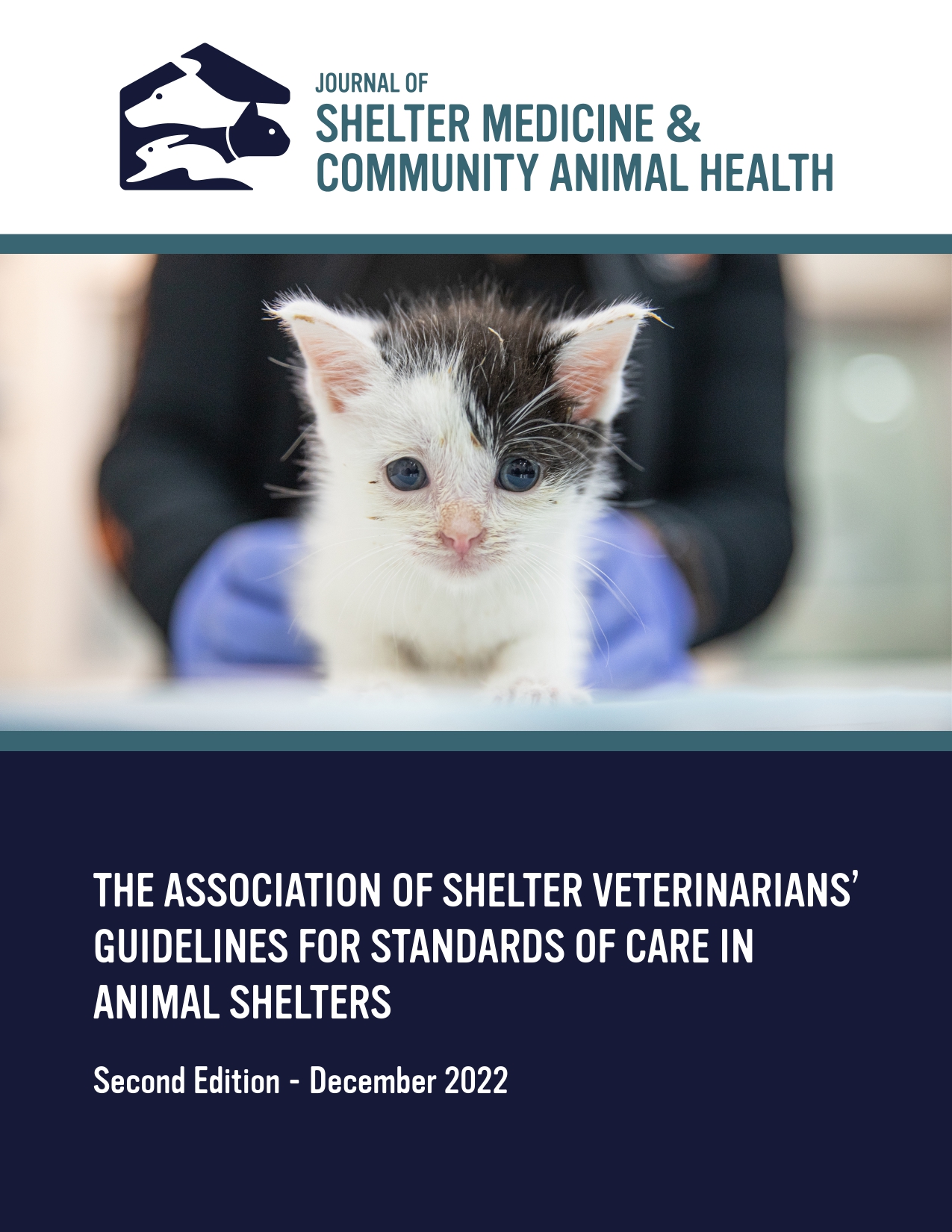A Mixed-Methods Exploration Of Opportunities For Barriers And Bias During Off Site Animal Adoption Events
DOI:
https://doi.org/10.56771/jsmcah.v3.66Keywords:
animal adoption, implicit bias, shelter management, capacity for careAbstract
Introduction: Adopters and animal shelter leaders are calling for higher equity in services provided by animal shelters to their communities. Specifically, restrictive pet adoption processes have been proposed as a threat to equitable service. The study had three specific goals: (1) to describe the basic characteristics of off-site adoption events, (2) to describe the adoption processes in use by shelters and to determine if there is any potential for unconscious bias in these processes, and (3) to determine if adoption practices differ depending on the characteristics of the animal shelter.
Methods: A total of 484 participants reported on how they conduct adoption events and their adopter selection procedures. Characteristics of organisations and their adoption event procedures were described and compared across organisation size using Chi-squared tests. Qualitative responses to open-ended questions asking about screening procedures were analysed through inductive thematic analysis.
Results: Commonly, adoption events were held weekly (n = 158, 33.1%) in locally owned stores (n = 259, 54.4%), with volunteers engaging directly with potential adopters (n = 423, 88.5%). Just under half responded that adopters could take pets straight home from the event (n = 229, 47.8%) and that the adoption process does not require a home visit (n = 276, 57.7%). Qualitative analysis revealed three major groups of themes: ‘methods of selection’, ‘information gathered by the animal shelter’, ‘information provided by the animal shelter’. The sub-theme of ‘Vibes’ (coded for 39.4% participants, n = 175) encompassed decision-making based on intuition or feeling when meeting or observing potential adopters face-to-face. Generally, larger organisations held adoption events more frequently, were more likely to let adopters take animals straight home, and did not require a home visit. However, both types of organisations showed a potential for implicit bias when selecting adopters.
Conclusion: Our results suggest that procedures of adoption events in animal shelters vary across organisation, with some practices differing based on organisation size. Given that our results suggest possibility for implicit bias when screening adopters during adoption events, we conclude that there is a need for increased awareness, research, and training to address the issue of implicit bias in animal sheltering organisations.
Downloads
References
Billock J. Want to Adopt a Pet? Prepare for a Full Background Check. The New York Times. 2021. https://www.nytimes.com/2021/06/22/style/pet-adoption-application.html. Accessed June 8, 2022.
Bahney A. So You Think You Can Just Adopt a Dog? The New York Times. 2006. https://www.nytimes.com/2006/03/23/fashion/thursdaystyles/so-you-think-you-can-just-adopt-a-dog.html. Accessed June 8, 2022.
Sinski J. ‘A Cat-Sized Hole in My Heart’: Public Perceptions of Companion Animal Adoption in the USA. In: Companion Animals in Everyday Life: Situating Human-Animal Engagement within Cultures. New York, NY: Palgrave Macmillan; 2016: 73–89. doi: 10.1057/978-1-137-59572-0_6
Hoy-Gerlach J, Ojha M, Arkow P. Social Workers in Animal Shelters: A Strategy toward Reducing Occupational Stress Among Animal Shelter Workers. Front Vet Sci. 2021;8:1343. doi: 10.3389/FVETS.2021.734396/BIBTEX
Hurley KF. The Evolving Role of Triage and Appointment-Based Admission to Improve Service, Care and Outcomes in Animal Shelters. Front Vet Sci. 2022;9:204. doi: 10.3389/fvets.2022.809340
Balcom S, Arluke A. Animal Adoption as Negotiated Order: A Comparison of Open versus Traditional Shelter Approaches. Anthrozoos. 2001;14(3):135–150. doi: 10.2752/089279301786999445
HumanePro. Adopters Welcome Manual. 2020. https://humanepro.org/page/adopters-welcome-manual. Accessed September 9, 2021.
Weiss E, Gramann S, Dolan ED, et al. Do Policy Based Adoptions Increase the Care a Pet Receives? An Exploration of a Shift to Conversation Based Adoptions at One Shelter. Open J Anim Sci. 2014;4(5):313–322. doi: 10.4236/OJAS.2014.45040
Best Friends Animal Society. Overcoming Adoption Barriers: Executive Summary. 2016. https://mcnt-files-prod.s3.us-west-1.amazonaws.com/inline-files/Adoption-Barrier-Study-Executive-Summary-Best Friends-062717.pdf. Accessed June 3, 2022.
Maddie’s Fund. Removing Barriers to Adoption. 2021. https://www.maddiesfund.org/removing-barriers-to-adoption.htm. Accessed July 7, 2021.
Ly LH, Gordon E, Protopopova A. Inequitable Flow of Animals in and Out of Shelters: Comparison of Community-Level Vulnerability for Owner-Surrendered and Subsequently Adopted Animals. Front Vet Sci. 2021;8:1351. doi: 10.3389/fvets.2021.784389
Griffin KE, John E, Pike T, Mills DS. Can This Dog Be Rehomed to You? A Qualitative Analysis and Assessment of the Scientific Quality of the Potential Adopter Screening Policies and Procedures of Rehoming Organisations. Front Vet Sci. 2020;7:1121. doi: 10.3389/fvets.2020.617525
Taylor N. In It for the Nonhuman Animals: Animal Welfare, Moral Certainty, and Disagreements. Soc Anim. 2004;12(4):317–339. doi: 10.1163/1568530043068047
Imdorf C. Emotions in the Hiring Procedure: How ‘Gut Feelings’ Rationalize Personnel Selection Decisions. In: Sieben B, Wettergren, A, eds. Emotionalizing Organizations and Organizing Emotions. London: Palgrave Macmillan; 2010:84–105. doi: 10.1057/9780230289895_5
Cocchiara FK, Bell MP, Casper WJ. Sounding ‘Different’: The Role of Sociolinguistic Cues in Evaluating Job Candidates. Hum Resour Manage. 2016;55(3):463–477. doi: 10.1002/HRM.21675
Marzine Harges B. Peremptory Challenges in Jury Selection in Louisiana-When a Gut Feeling Is Not Enough. Loyola Law Rev. 2008;54. https://heinonline.org/HOL/Page?handle=hein.journals/loyolr54&id=110&div=&collection=. Accessed April 9, 2023.
Rosen E, Garboden PME, Cossyleon JE. Racial Discrimination in Housing: How Landlords Use Algorithms and Home Visits to Screen Tenants. Am Sociol Rev. 2021;86(5):787–822. doi: 10.1177/00031224211029618
Cohn LA. Feline Respiratory Disease Complex. Vet Clin North Am Small Anim Pract. 2011;41(6):1273–1289. doi: 10.1016/j.cvsm.2011.07.006
Helps CR, Lait P, Damhuis A, et al. Factors Associated with Upper Respiratory Tract Disease Caused by Feline herpesvirus, Feline calicivirus, Chlamydophila Felis and Bordetella bronchiseptica in Cats: Experience from 218 European Catteries. Vet Rec. 2005;156(21):669–673. doi: 10.1136/VR.156.21.669
Wells DL. A Review of Environmental Enrichment for Kennelled Dogs, Canis Familiaris. Appl Anim Behav Sci. 2004;85(3–4):307–317. doi: 10.1016/J.APPLANIM.2003.11.005
Karsten CL, Wagner DC, Kass PH, Hurley KF. An observational study of the relationship between Capacity for Care as an Animal Shelter Management Model and Cat Health, Adoption and Death in Three Animal Shelters. Vet J. 2017;227:15–22. doi: 10.1016/J.TVJL.2017.08.003
Marston LC, Bennett PC, Coleman GJ. What Happens to Shelter Dogs? An Analysis of Data for 1 Year from Three Australian Shelters. J Appl Anim Welf Sci. 2004;7(1):27–47. doi: 10.1207/s15327604jaws0701_2
Jacobs J, Reese LA. Compassion Fatigue among Animal Shelter Volunteers: Examining Personal and Organizational Risk Factors. Anthrozoos. 2021;34(6):803–821. doi: 10.1080/08927936.2021.1926719/SUPPL_FILE/RFAN_A_1926719_SM8702.PDF
Hobson SJ, Bateman S, Coe JB, Oblak M, Veit L. The Impact of Deferred Intake as Part of Capacity for Care (C4C) on Shelter Cat Outcomes. J Appl Anim Welf Sci. 2023;26(1):68–79. doi: 10.1080/10888705.2021.1894148
Best Friends Animal Society. Dog, Cat & Pet Adoption Event Manual. 2019. https://resources.bestfriends.org/article/how-conduct-successful-adoption-events. Accessed June 9, 2022.
Weiss E, Patronek G, Slater M, Garrison L, Medicus K. Community Partnering as a Tool for Improving Live Release Rate in Animal Shelters in the United States. J Appl Anim Welf Sci. 2013;16(3):221–238. doi: 10.1080/10888705.2013.803816
RStudio Team. RStudio; 2021. https://www.rstudio.com/. Accessed August 18, 2021.
Percy W, Kostere K, Kostere S. Generic Qualitative Research in Psychology. Qual Rep. 2015;20(2):76–85. doi: 10.46743/2160-3715/2015.2097
Neumann SL. Animal Welfare Volunteers: Who Are They and Why Do They Do What They Do? Anthrozoos. 2010;23(4): 351–364. doi: 10.2752/175303710X12750451259372
Wang D, Chen C-W, You Y-Y, et al. Optimizing the Adoption Process in Public Animal Shelters through Service Design Thinking. Conference Proceedings of Synergy – DRS International Conference. August 11-14, 2020;1. Held online. doi: 10.21606/DRS.2020.173
Kresnye KC, Shih PC. ‘We Have a Volunteer Coordinator Who Is Unfortunately a Volunteer’: A Qualitative Assessment of Animal Shelters. ACI’18: Proceedings of the Fifth International Conference on Animal-Computer Interaction. December 4-6, 2018. New York, NY. doi: 10.1145/3295598
Buley J. Assessing and Addressing Pet Owner Obstacles to Companion Animal Care: Parvovirus Prevention in Milwuakee. Paper presented at: International Forum for Applied Animal Behaviour; 2017; Austin, Texas. Accessed February 4, 2023.
Taylor N. ‘Never an It’: Intersubjectivity and the Creation of Animal Personhood in Animal Shelters. Qual Sociol Rev. 2007;3(1):59–73. doi: 10.18778/1733-8077.3.1.05
Saunders J, Parast L, Babey SH, Miles JV. Exploring the Differences between Pet and Non-Pet Owners: Implications for Human-Animal Interaction Research and Policy. PLoS One. 2017;12(6):1–16. doi: 10.1371/journal.pone.0179494
Leslie BE, Meek AH, Kawash GF, McKeown DB. An Epidemiological Investigation of Pet Ownership in Ontario. Can Vet J. 1994;35(4):218–222.
Morin R. Exploring Racial Bias among Biracial and Single-Race Adults: The IAT. 2015. https://www.pewresearch.org/social-trends/2015/08/19/exploring-racial-bias-among-biracial-and-single-race-adults-the-iat/. Accessed April 9, 2023.

Published
Issue
Section
License
Copyright (c) 2024 Lexis H. Ly, Kelsea Brown, Emily Yau, Becky Kenworthy, Sheila Segurson, Alexandra Protopopova

This work is licensed under a Creative Commons Attribution 4.0 International License.









